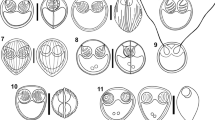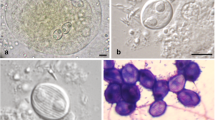Abstract
The Patagonian seabass Acanthistius patachonicus (Jenyns, 1840) (Serranidae) is a marine fish valued for commercial and sport fisheries from Argentina. We report a new myxosporean (Cnidaria: Myxozoa) infecting the urinary system of the Patagonian seabass from San Antonio Bay, San Matías Gulf, on the Atlantic Ocean. The mature myxospores were subspherical, 8.2–11.0 μm × 7.9–11.0 μm and 7.7–9.0 μm in thickness; two subspherical polar capsules, 2.4–3.8 μm × 2.3–3.6 μm, with 3 to 4 turns of the polar tubule; openings on different valves in almost opposite directions. Ornamented shell valves exhibited 17–20 concentrically organized surface ridges. SSU rDNA phylogenetics analyses placed the new species in the freshwater urinary tract clade, clustering in a clade formed by Myxobilatus gasterostei (Parisi, 1912), Acauda hoffmani Whipps, 2011, and other Ortholinea spp. Based on spore morphology, site of infection, and molecular data, we described this myxozoan as Ortholinea concentrica n. sp.





Similar content being viewed by others
References
Abdel-Baki AAS, Soliman H, Saleh M, Al-Quraishy S, El-Matbouli M (2015) Ortholinea saudii sp. nov. (Myxosporea: Ortholineidae) in the kidney of the marine fish Siganus rivulatus (Teleostei) from the Red Sea, Saudi Arabia. Dis Aquat Org 113:25–32. https://doi.org/10.3354/dao02821
Abdel-Ghaffar F, El-Toukhy A, Al-Quraishy S, Al-Rasheid K, Abdel-Baki AS, Hegazy A, Bashtar AR (2008) Five new myxosporean species (Myxozoa: Myxosporea) infecting the Nile tilapia Oreochromis niloticus in Bahr Shebin, Nile Tributary, Nile Delta, Egypt. Parasitol Res 103:1197–1205. https://doi.org/10.1007/s00436-008-1116-z
Alama-Bermejo G, Bron JE, Raga JA, Holzer AS (2012) 3D morphology, ultrastructure and development of Ceratomyxa puntazzi stages: first insights into the mechanisms of motility and budding in the Myxozoa. PLoS One 7:e32679. https://doi.org/10.1371/journal.pone.0032679
Alama-Bermejo G, Jirků M, Kodádková A, Pecková H, Fiala I, Holzer AS (2016) Species complexes and phylogenetic lineages of Hoferellus (Myxozoa, Cnidaria) including revision of the genus: a problematic case for taxonomy. Parasit Vectors 9(13):13. https://doi.org/10.1186/s13071-015-1265-8
Ali MA (2000) Ortholinea basma n. sp. (Myxozoa: Myxosporea) from agile klipfish Clinus agilis (Teleostei: Clinidae), light and scanning electron microscopy. Eur J Protistol 36:100–102. https://doi.org/10.1016/S0932-4739(00)80026-7
Andree KB, MacConnell E, Hedrick RP (1998) A nested polymerase chain reaction for the detection of genomic DNA of Myxobolus cerebralis in rainbow trout Oncorhynchus mykiss. Dis Aquat Org 34:145–154. https://doi.org/10.3354/dao034145
Aseeva NL (2000) Myxosporea from anadromous and coastal fishes from the northwestern Japan Sea. Izv TINRO 127:593–606 (In Russian)
Aseeva NL (2002) Myxosporidian fauna from Gadidae in the Far East Sea. Parazitologiya 36:167–174 (In Russian)
Atkinson SD, Bartholomew JL (2009) Alternate spore stages of Myxobilatus gasterostei, a myxosporean parasite of three-spined sticklebacks (Gasterosteus aculeatus) and oligochaetes (Nais communis). Parasitol Res 104:1173–1181. https://doi.org/10.1007/s00436-008-1308-6
Benajiba MH, Marques A (1993) The alternation of actinomyxidian and myxosporidian sporal forms in the development of Myxidium giardi (parasite of Anguilla anguilla) through oligochaetes. Bull Eur Assoc Fish Pathol 13:100–103
Ben-David J, Atkinson SD, Pollak Y, Yossifon G, Shavit U, Bartholomew JL, Lotan T (2016) Myxozoan polar tubules display structural and functional variation. Parasit Vectors 9:549. https://doi.org/10.1186/s13071-016-1819-4
Darriba D, Taboada GL, Doallo R, Posada D (2012) jModelTest 2: more models, new heuristics and parallel computing. Nat Methods 9:772. https://doi.org/10.1038/nmeth.2109
Davis HS (1917) The Myxosporidia of the Beaufort region, a systematic and biologic study. Bulletin of the United States Bureau of Fisheries, document no. 855, issued December 17, 1917
El-Matbouli M, Fischer-Scherl T, Hoffmann RW (1992) Transmission of Hoferellus carassii Achmerov, 1960 to goldfish Carassius auratus via an aquatic oligochaete. Bull Eur Assoc Fish Pathol 12:54–56
Fiala I (2006) The phylogeny of Myxosporea (Myxozoa) based on small subunit ribosomal RNA gene analysis. Int J Parasitol 36:1521–1534. https://doi.org/10.1016/j.ijpara.2006.06.016
Fiala I, Bartošová-Sojková P, Whipps CM (2015a) Classification and phylogenetics of Myxozoa. In: Okamura B, Gruhl A, Bartholomew J (eds) Myxozoan Evolution, Ecology and Development. Springer, Cham, pp 85–110. https://doi.org/10.1007/978-3-319-14753-6_5
Fiala I, Bartošová-Sojková P, Okamura B, Hartikainen H (2015b) Adaptive radiation and evolution within the Myxozoa. In: Okamura B, Gruhl A, Bartholomew J (eds) Myxozoan Evolution. Ecology and Development. Springer, Cham, pp 69–84. https://doi.org/10.1007/978-3-319-14753-6_4
Galván DE, Venerus LA, Irigoyen AJ (2009) The reef-fish fauna of the northern Patagonian gulfs, Argentina, South-western Atlantic. The Open Fish Science Journal 2:90–98. https://doi.org/10.2174/1874401X00902010090
Groβheider G, Körting W (1992) First evidence that Hoferellus cyprini (Doflein, 1898) is transmitted by Nais sp. Bull Eur Assoc Fish Pathol 12:17–20
Gürkanlı CT, Okkay S, Çiftçi Y, Yurakhno V, Özer A (2018) Morphology and molecular phylogeny of Ortholinea mullusi sp. nov. (Myxozoa) in Mullus barbatus from the Black Sea. Dis Aquat Org 127:117–124. https://doi.org/10.3354/dao03192
Hallett SL, Diamant A (2001) Ultrastructure and small-subunit ribosomal DNA sequence of Henneguya lesteri n.sp. (Myxosporea), a parasite of sand whiting Sillago analis (Sillaginidae) from the coast of Queensland, Australia. Dis Aquat Org 46:197–212. https://doi.org/10.3354/dao046197
Hillis DM, Dixon MT (1991) Ribosomal DNA: molecular evolution and phylogenetic inference. Q Rev Biol 66:411–453
Holzer AS, Sommerville C, Wootten R (2004) Molecular relationships and phylogeny in a community of myxosporeans and actinosporeans based on their 18S rDNA sequences. Int J Parasitol 34:1099–1111. https://doi.org/10.1016/j.ijpara.2004.06.002
Holzer A, Sommerville C, Wootten R (2006) Molecular studies on the seasonal occurrence and development of five myxozoans in farmed Salmo trutta L. Parasitology 132:193–205. https://doi.org/10.1017/S0031182005008917
Holzer AS, Bartošová-Sojková P, Born-Torrijos A, Lövy A, Hartigan A, Fiala I (2018) The joint evolution of the Myxozoa and their alternate hosts: a cnidarian recipe for success and vast biodiversity. Mol Ecol 27:1651–1666. https://doi.org/10.1111/mec.14558
Irigoyen AJ, Gerhardinger L, Carvalho Filho A (2008) On the status of the species of Acanthistius (Gill, 1862) (Percoidei) in the South-West Atlantic Ocean. Zootaxa 1813:51–59
Karlsbakk E, Køie M (2011) Morphology and SSU rDNA sequences of Ortholinea orientalis (Shul’man and Shul’man-Albova, 1953) (Myxozoa, Ortholineidae) from Clupea harengus and Sprattus sprattus (Clupeidae) from Denmark. Parasitol Res 109:139–145. https://doi.org/10.1016/j.ijpara.2004.06.002
Karlsbakk E, Kristmundsson A, Albano M, Brown P, Freeman MA (2017) Redescription and phylogenetic position of Myxobolus aeglefini and Myxobolus platessae n. comb. (Myxosporea), parasites in the cartilage of some North Atlantic marine fishes, with notes on the phylogeny and classification of the Platysporina. Parasitol Int 66:952–959. https://doi.org/10.1016/j.parint.2016.10.014
Kovalyova AA, Velev P, Vladev P (1993) New data on myxosporidians (Cnidospora:Myxosporea) fauna from commercial fishes of the Atlantic coast of Africa. In: Bukatin PA (ed) Ecology and Resources of Commercial Fishes of the Eastern Atlantic. AtlantNIRO, Kaliningrad, pp 174–194 (In Russian)
Lom J, Arthur R (1989) A guideline for the preparation of species descriptions in Myxosporea. J Fish Dis 12:151–156
Lom J, Dyková I (1995) New species of the genera Zschokkella and Ortholinea (Myxozoa) from the southeast Asian teleost fish, Tetraodon fluviatilis. Folia Parasitol 42:161–168
Lom J, Rohde K, Dyková I (1992) Studies on protozoan parasites of Australian fishes. 1. New species of the genera Coccomyxa Léger et Hesse, 1907, Ortholinea Shulman, 1962 and Kudoa Meglitsch, 1947 (Myxozoa, Myxosporea). Folia Parasitol 39:289–306
MacKenzie K, Kalavati C (2014) Myxosporean parasites of marine fishes: their distribution in the world's oceans. Parasitology 141:1709–1717. https://doi.org/10.1017/S0031182014001425
Matos PS, Silva DT, Hamoy I, Matos E (2018) Morphological features and molecular phylogeny of Hoferellus azevedoi n. sp. (Myxozoa: Myxobilatidae) found in Chaetobranchus flavescens Heckel, 1840 (Teleostei: Cichlidae) from Marajó Island, northern Brazil. Parasitol Res 117:1087–1093. https://doi.org/10.1007/s00436-018-5785-y
Meglitsch PA (1970) Some coelozoic myxosporida from New Zealand fishes: family Sphaerosporidae. J Protozool 17:112–115. https://doi.org/10.1111/j.1550-7408.1970.tb05168.x
Moshu AJ, Trombitsky ID (2006) New parasites (Apicomplexa, Cnidospora) of some Clupeidae fishes from the Danube and Dniestr basins. Eco-TIRAS International Environmental Association of River Keepers Leo Berg Educational Foundation Academician Leo Berg – Collection of Scientific Articles 130:95–103
Naidenova NN (1968) Ortholinea gobiusi sp. nov. from Gobius ophiocephalus of the Black Sea. Biologiya Morya, Kiev 14:60–62 (in Russian)
Okamura B, Gruhl A, Bartholomew JL (2015) An introduction to myxozoan evolution, ecology and development. In: Okamura B, Gruhl A, Bartholomew J (eds) Myxozoan Evolution, Ecology and Development. Springer, Cham, pp 1–20. https://doi.org/10.1007/978-3-319-14753-6_1
Padma DK, Kalavati C (1993) A new myxosporean parasite, Ortholinea visakhapatnamensis n.sp from the mullet, Liza macrolepis from Visakhapatnam harbour, India. Riv Parassitol 54:461–465
Rangel LF, Rocha S, Borkhanuddin MH, Cech G, Castro R, Casal G, Azevedo C, Severino R, Székely C, Santos MJ (2014) Ortholinea auratae n. sp. (Myxozoa, Ortholineidae) infecting the urinary bladder of the gilthead seabream Sparus aurata (Teleostei, Sparidae), in a Portuguese fish farm. Parasitol Res 113:3427–3437. https://doi.org/10.1007/s00436-014-4008-4
Rangel LF, Rocha S, Castro R, Severino R, Casal G, Azevedo C, Cavaleiro F, Santos MJ (2015) The life cycle of Ortholinea auratae (Myxozoa: Ortholineidae) involves an actinospore of the triactinomyxon morphotype infecting a marine oligochaete. Parasitol Res 114:2671–2678. https://doi.org/10.1007/s00436-015-4472-5
Rangel LF, Rocha S, Casal G, Castro R, Severino R, Azevedo C, Cavaleiro F, Santos MJ (2017) Life cycle inference and phylogeny of Ortholinea labracis n. sp. (Myxosporea: Ortholineidae), a parasite of the European seabass Dicentrarchus labrax (Teleostei: Moronidae), in a Portuguese fish farm. J Fish Dis 40:243–262. https://doi.org/10.1111/jfd.12508
Ronquist F, Huelsenbeck J (2003) MrBayes 3: Bayesian phylogenetic inference under mixed models. Bioinformatics 19:1572–1574. https://doi.org/10.1093/bioinformatics/btg180
Schlegel M, Lom J, Stechmann A, Bernhard D, Leipe D, Dyková I, Sogin ML (1996) Phylogenetic analysis of complete small subunit ribosomal RNA coding region of Myxidium lieberkuehni: evidence that Myxozoa are Metazoa and related to the Bilateria. Arch Protistenkd 147:1–9. https://doi.org/10.1016/S0003-9365(96)80002-9
Shulman SS, Shulman-Albova RE (1953) Parasites of fishes of the White Sea. Akad Nauk SSSR, Moscow, p 198 (In Russian)
Stamatakis A, Ludwig T, Meier H (2005) RAxML-III: a fast program for maximum likelihood-based inference of large phylogenetic trees. Bioinformatics 21:456–463. https://doi.org/10.1093/bioinformatics/bti191
Su X, White RWG (1994) New myxosporeans (Myxozoa:Myxosporea) from marine fishes of Tasmania, Australia. Acta Protozool 33:251–259
Swofford DL (2002) PAUP*. Phylogenetic analysis using parsimony (*and other methods). Sinauer Associates, Sunderland, Massachusetts, USA
Thélohan P (1895) Recherches sur les Myxosporidies. Bull Sci Fr Belg 5:100–394
Trouillier A, El-Matbouli M, Hoffmann W (1996) A new look at the life-cycle of Hoferellus carassii in the goldfish (Carassius auratus auratus) and its relation to “kidney enlargement disease” (KED). Folia Parasitol 43:173–187
Videira M (2015) Aspectos morfológicos, histopatológicos e moleculares de micoparasitas de Aequidens plagiozonatus Kullander, 1984 (Teleostei:Cichlidae) e de Gobioides broussonnetii Lacepede, 1800 (Teleostei: Gobiidae) provenientes da Amazonia paraense. Dissertation, Universidade Federal do Pará
Whipps CM (2011) Interrenal disease in bluegills (Lepomis macrochirus) caused by a new genus and species of myxozoan. J Parasitol 97:1159–1165. https://doi.org/10.1645/GE-2763.1
Whipps CM, Adlard RD, Bryant MS, Lester RJG, Findlay V, Kent ML (2003) First report of three Kudoa species from eastern Australia: Kudoa thyrsites from mahi mahi (Coryphaena hippurus), Kudoa amamiensis and Kudoa minithyrsites n. sp. from sweeper (Pempheris ypsilychnus). J Eukaryot Microbiol 50:215–219. https://doi.org/10.1111/j.1550-7408.2003.tb00120.x
Whipps CM, Murray KN, Kent ML (2015) Occurrence of a myxozoan parasite Myxidium streisingeri n. sp. in laboratory zebrafish Danio rerio. J Parasitol 101:86–90. https://doi.org/10.1645/14-613.1
Wierzbicka J (1986) Sphaerospora sphaerocapsularae sp. n. (Myxospora, Bivalvulida) a parasite of eel, Anguilla anguilla (L.). Acta Protozool 25:355–358
Wünnemann H, Holzer AS, Pecková H, Bartošová-Sojková P, Eskens U, Lierz M (2016) Repatriation of an old fish host as an opportunity for myxozoan parasite diversity: the example of the allis shad, Alosa alosa (Clupeidae), in the Rhine. Parasite Vector 9(505):505. https://doi.org/10.1186/s13071-016-1760-6
Yokoyama H, Ogawa K, Wakabayashi H (1993) Involvement of Branchiura sowerbyi (Oligochaeta, Annelida) in the transmission of Hoferellus carassii (Myxosporea, Myxozoa), the causative agent of kidney enlargement disease (KED) of goldfish Carassius auratus. Fish Pathol 28:135–139. https://doi.org/10.3147/jsfp.28.135
Zhang ZQ (2011) Animal biodiversity: an outline of higher-level classification and taxonomic richness. Zootaxa 3148:1–237
Acknowledgments
We are grateful to Dennis Landete, Juan Saad, and Pablo Jerez for their assistance during the collection of the seabass and to Martina Tesařová for electron microscopy assistance (Laboratory of Electron Microscopy, Institute of Parasitology, Czech Academy of Sciences).
Funding
This study received funding from the Czech Science Foundation (Grant No. 14–28784P and P505/12/G112).
Author information
Authors and Affiliations
Corresponding author
Ethics declarations
Conflict of interest
The authors declare that they have no conflict of interest.
Ethical approval
All applicable institutional, national and international guidelines for the care and use of animals were followed.
Additional information
Section Editor: Sascha L. Hallett
Rights and permissions
About this article
Cite this article
Alama-Bermejo, G., Hernández-Orts, J.S. Ortholinea concentrica n. sp. (Cnidaria: Myxozoa) from the Patagonian seabass Acanthistius patachonicus (Jenyns, 1840) (Perciformes: Serranidae) off Patagonia, Argentina. Parasitol Res 117, 3953–3963 (2018). https://doi.org/10.1007/s00436-018-6105-2
Received:
Accepted:
Published:
Issue Date:
DOI: https://doi.org/10.1007/s00436-018-6105-2




